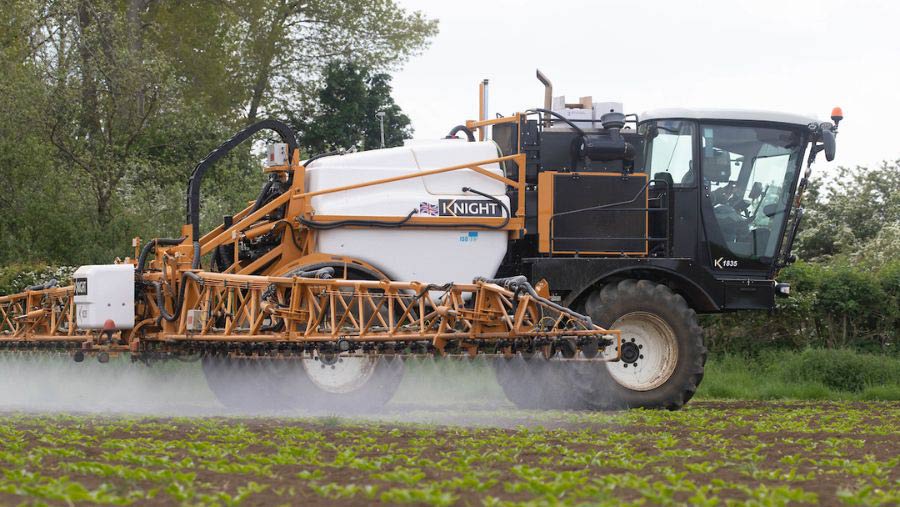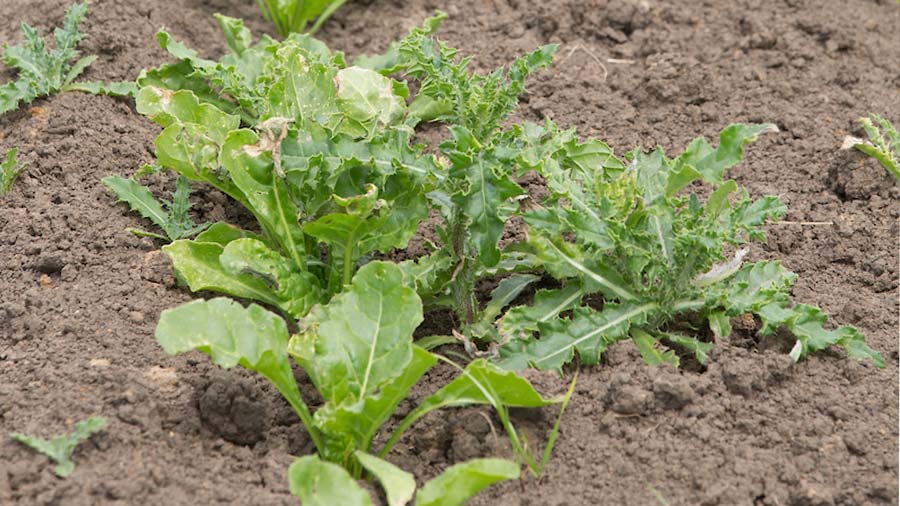Herbicide-tolerant sugar beet draws growers amid high costs
 © Tim Scrivener
© Tim Scrivener The greater flexibility on offer from herbicide-tolerant sugar beet is attracting more growers to the combined system, but the right stewardship and management remains essential.
Originally launched ahead of the 2020 growing season, Conviso Smart sugar beet is the result of a collaboration between plant breeder KWS and agrochemical specialist Bayer Crop Science.
It consists of two components – an actolactate synthase (ALS) inhibitor herbicide-tolerant sugar beet variety and a specially developed post-emergence herbicide known as Conviso One.
See also: The rare moth putting sugar beet yields at risk this autumn
The growing system was originally targeted at weed beet problems so that growers could bring infested fields back into the rotation.
Exploiting the genetics and cutting back to one spray would reduce the number of herbicide applications applied to a crop.
This would lead to minimising crop damage, as well as simplifying weed control and reducing workloads, it was claimed.
Two years on and the system is finding favour with growers who are committed to sugar beet.
Most sugar beet growers stress the importance of getting the spray timing right, especially in springs where weed emergence is protracted.
Conviso One offers broad-spectrum weed control from just one application of 1l/ha, made at the two to four true leaf stage of the target weeds.
This is usually when the second spray of a conventional herbicide programme would be applied.
Crucially, it can only be used on varieties with ALS-tolerance, the first of which was Smart Janninka KWS.
Smart Janninka KWS has now been removed from the British Beet Research Organisation (BBRO) Recommended List and replaced by higher-yielding Smart Rixta KWS and BTS Smart 9485.
Record-keeping
As a result, keeping accurate records of varieties at drilling and spraying is essential. Active bolter management is also important, with the system best suited to whole field situations.
Initially seen as a very specific tool for a weed beet problem, the subsequent loss of useful chemistry for the sugar beet crop and the rising costs associated with beet growing have changed the way the system is viewed.
As Hutchinsons agronomist Ed Stevens explains, growers in his Norfolk region have adopted the system for various reasons.
These include overcoming a serious weed beet problem to simplifying the job of beet growing, especially when they are covering multiple sites.
“It has allowed fields that weren’t suitable for sugar beet growing to come back into the rotation, and it has delivered a sprayer capacity bonus,” he says.
“It has also replaced the need for hand-pulling weed beet.”
His experience is that growers have found additional benefits as they have gained confidence in the system.
These include both volunteer potato and grass weed control, as well as less herbicide damage to crops.
Yield penalty
“There is a slight yield penalty, although yields have been better than we had anticipated, as British Beet Research Organisation published yields come from crops grown under a conventional herbicide programme and may not show the safety benefit of using Conviso One on tolerant crops,” he says.
“Making just one herbicide application can be a dilemma, depending on fat hen pressure, with some growers opting to use a holding spray while they wait for the flush of weed beet.”
The additional cost of the system shouldn’t be considered at in isolation, he advises.
“Using one spray instead of four is a saving in both time and money, while the management of the crop becomes much simpler.
“The cost of pulling weed beet has gone up and can be the same as the extra paid for the combined seed/herbicide pack. So it’s definitely worth a closer look.”
Mr Stevens anticipates that the area of Conviso beet being grown in his area will increase from 15% to up to 30% in 2023.
“There are agronomic, environmental and workload reasons for this – every farm is different.”
Case study: Ben Jones, North Norfolk
For North Norfolk sugar beet grower Ben Jones, the Conviso Smart sugar beet system is working very well.
Having grown it for the past two years, both on his home farm and three contract farms, Mr Jones points out that the ease of management that comes with the system has been the main bonus to date.
Agronomic and environmental benefits
It has also allowed him to bring land back into the rotation for growing sugar beet, while he no longer has the hand labour bill associated with pulling weed beet or concerns about crop damage.
“Conviso beet has done more for us than we thought it would, as there are agronomic and environmental benefits from the system, as well as the easier management,” he says.
“Financially, it stacks up about the same as conventional beet. The initial outlay for the seed and herbicide combination is hefty, at £365/ha last year, but using fewer sprays and no hand labour balances that out.”
Applying just one herbicide, compared with the three to four sprays that he uses on conventional sugar beet for weed control, has helped with workloads and simplified agronomy, as well as proving to be kinder to the crop.
“The timing of the one herbicide application is critical,” he says. “I don’t use a holding spray at all, so we have to be spot-on with the Conviso One spray.”

The herbicide is very good at managing broad-leaved weeds such as thistle © Tim Scrivener
Coastal location
The farm’s location close to the coast means that early drilling is a non-starter, so fat hen is not as problematic as it can be for some beet growers.
Conviso sugar beet was initially introduced to weed beet problem areas on one of his four farms. The impressive results on weeds encouraged him to grow more of it.
“It’s very good on volunteer potatoes, thistles and grassweeds,” he says. “We don’t have a big blackgrass problem here, but we do have meadowgrass, bromes and ryegrass – it has worked very well on all of those.”
As a result, he hasn’t had to apply a graminicide at all, but adds that the use of fungicides and an insecticide, if necessary, is just the same on Conviso beet as it is on a conventional crop.
“We grow conventional beet as well, so we have to be very aware of stewardship and the potential cross-contamination issue,” accepts Mr Jones.
“We do have a designated sugar beet sprayer and have to be scrupulous about cleaning it out, but that should be done as good practice.”
Variety choice
Mr Jones has grown Janninka to date but has some Rixta in the ground this year, which he believes is higher yielding.
“In general, the Conviso varieties don’t yield as well as conventional varieties, at around 5-8% less,” he says. “One observation is that the roots don’t seem to grow as big.”
He has also seen fewer virus yellows in the Conviso beet, but is uncertain whether that’s a coincidence or not.
“It hasn’t been knocked by the virus in the way that conventional beet can be.”
With outdoor pigs on the farms, most of the sugar beet grown follows on behind them, making the most of the fertility left by the pigs.
“It fits very well. Our growing costs have gone up hugely, so being able to replace the need for some bagged fertiliser helps.”
The better sugar beet price of £40/t has persuaded Mr Jones to stick with sugar beet for now and he expects that 75% of his crop will be Conviso Smart next year.

